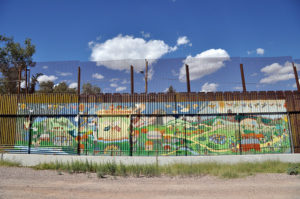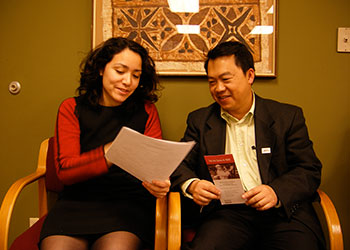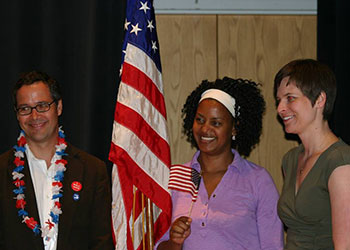
During the campaign, Donald Trump got cheers every time he promised to “build that wall” between Mexico and the United States. He promised his loyal supporters that “Mexico will pay for it.” Fast forward to April 2017, and both promises have gone down in flames.
First, there’s the wall itself. The federal government solicited bids to build prototypes – not the wall, just prototypes. This bidding period ended on April 4, with more than 200 companies listed on an “interested vendors list,” though no one knows how many actually submitted bids. The Trump administration is expected to pick up to ten companies. Each will build a prototype costing between $200,000 and $500,000.
The specs for the wall call for a pretty side facing the U.S., and an overall design that can withstand sledgehammers, climbers, tunnels, anymore.
Paying for the wall
Finding a contractor is the least of DT’s problems with the wall. More important:
The U.S.-Mexico border stretches more than 2,000 miles. According to NPR, “The Department of Homeland Security has estimated the cost of the wall at $21 billion. An MIT study puts the price tag at $38 billion.” Mexico is not going to pay, and there is no way for Trump to make them pay. Some Republicans floated an idea for a tax on goods imported from Mexico. Aside from dubious legality, such a tax would just be passed on to U.S. consumers. That doesn’t sound like “making Mexico pay.”
Who wants the wall?
Nobody who knows anything thinks a continuous border wall will happen – or should. The head of the Border Patrol agents union told the Senate, “We don’t need a great wall of the United States. We do not need 2,000 miles of border wall. I will tell you, however, that a wall in strategic locations is absolutely necessary.” He says agents are more important than a wall.
Even John Kelly, Trump’s head of the Department of Homeland Security, concedes that the wall will not cover the entire border. He told the Senate Homeland Security Committee that he is committed to putting the wall where immigration agents think it is needed, but not “from sea to shining sea.”
Most Americans do not think a wall would work. A Pew Research poll in February 2017 showed 62 percent of all Americans opposing the wall. Most also think a wall would not work:
“The latest national survey by Pew Research Center, conducted Feb. 7-12, 2017 among 1,503 adults, finds the public holds mixed views on a border wall’s potential impact on illegal immigration. About three-in-ten (29%) think a wall along the entire border with Mexico would lead to a “major reduction” in illegal immigration into the U.S.; another 25% think it would result in a “minor reduction.” A 43% plurality thinks a border wall would not have much impact on illegal immigration into the U.S.”
Opposition to a border wall ran much higher among people under 50 years of age, and among black and Hispanic residents.
Violating tribal sovereignty
The Tohono O’odham tribe says building a wall across its territory would violate tribal sovereignty – as well as separating the Tohono O’odham nation members on both sides of the border. Indian Country Today talked to Jose García, the Tohono O’odham Nation Lieutenant Governor for the O’odham in Mexico:
“If a wall was built it would completely shut off the visitations between O’odham families and medical services,” Garcia said.
“Furthermore, a border wall would break off the relationship O’odham in Mexico have with the Tohono O’odham Nation, and affect the O’odham language, which Garcia is trying to revive in certain areas of Mexico.”
Eminent Domain: Not really a Republican favorite
To build the wall, the Trump administration would have to take land from Americans who don’t want to sell and don’t want the wall – people like 88-year-old Pamela Taylor, who voted for Trump, but told The Atlantic:
“As far as we’re concerned, the fence is not going to work. This fence is not working,” she said. “When you’re not here and you don’t know the area and then you say something, it’s best to get your ducks in a row.” If the administration were to present her a condemnation notice, she told me she would “definitely” take it to court.”
She’s not alone – landowner opposition to eminent domain – government taking of private property – is deep-rooted and traditionally Republican.
Will any wall get built?
At this point, the future of “the wall” seems dim. Something will probably get built, somewhere, some time, but it won’t look much like the “big, beautiful wall” that Trump promised/threatened and still claims will happen.
Maybe he should have listened to American poet Robert Frost’s Mending Wall warning:
Before I built a wall I’d ask to know
What I was walling in or walling out,
And to whom I was like to give offence.
Something there is that doesn’t love a wall,
That wants it down.
For more information:
- Most Americans continue to oppose U.S. border wall, doubt Mexico would pay for it (Pew Research, 2/24/17)
- Bidding Closes for Building Trump’s Border Wall (NPR, 4/4/17)
- Trump’s Border Barrier Hits a Wall (The Atlantic, 4/6/17)
- Wall won’t span the entire U.S.-Mexico border, Homeland Security secretary concedes (Los Angeles Times, 4/5/17)
- Border Agency Fields Pitches for Trump’s Wall With Mexico (AP, 4/4/17)
- U.S.-Mexico border wall needed only in ‘strategic locations,’ says border patrol union head (ABC News, 3/23/17)
- Border Wall Would Cut Across Land Sacred to Native Tribe (NPR, 2/23/17)
- Border Wall Would Cleave Tribe and Its Connection to Ancestral Land (New York Times, 2/20/17)
- Trump’s Border Wall Builds Apprehension Across Tohono O’odham Nation (Indian Country Today, 2/9/17)









